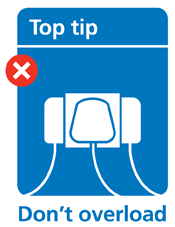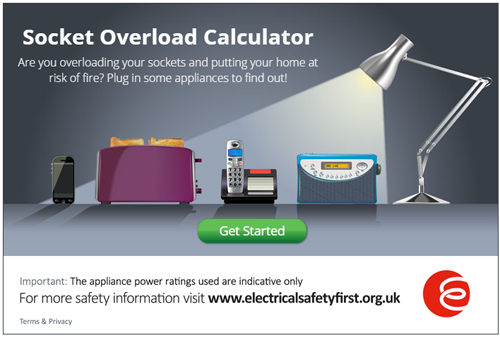Plugs, appliances and wiring
 Just because there are no flames, doesn’t mean there isn't a fire risk.
Just because there are no flames, doesn’t mean there isn't a fire risk.
Electrical appliances, plugs and cables that are old or poorly wired can be a real danger. There are particular danger signs to look out for on all electrical items you have around your home. If you think something needs fixing or changing do it straight away.
Plugs and socket
- Hot plugs or sockets, scorch marks, fuses that often blow, or flickering light are all signs of loose wiring or other electrical problems.
- Badly wired plugs. Any coloured wires sticking out could come loose and debris could also get into the plug
- Overloaded sockets. Plugging too many electrical appliances into one socket can lead to overheating

- Use sockets safely. It’s better to use a bar adaptor (multi board) on a lead than a block adaptor
- Only use one adaptor per socket. Don’t plug one adaptor into another and try to keep to one plug per socket
- Don't overload extension leads and adaptors, they have a limit on how many amps they can take.
Fuses
- When you’re fitting or replacing a fuse, it’s important to use the right fuse for the appliance to make sure the fuse doesn’t overheat.
- Check the manual or look for a sticker on the appliance to find out its wattage and then use the correct fuse.
- For appliances:
- up to 700 watts, use a 3 amp fuse
- 700 and 1,000 watts, use a 5 amp fuse
- more than 1,000 watts, use a 13 amp fuse.
Cables and leads
- Make sure the outer covering of all power leads is in good condition. Replace frayed or damaged cables or leads.
- Being badly positioned. They shouldn’t be anywhere that they could be tripped over, or near water, cookers or other sources of heat.
- Never run them under rugs or carpets where they can wear through without anyone noticing. Position them elsewhere.
Appliances
- Never get them wet. This includes plugs and sockets, so don’t put a vase of flowers on top of the TV, for example.
- Never leave them on at night. Unless they are designed to be left on, like freezers.
- Put anything in the microwave that is made of metal, or has a metallic finish or parts.
